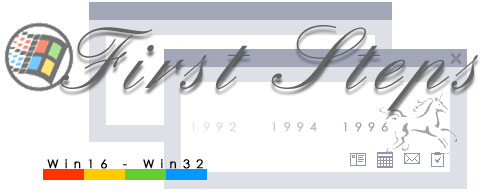The History of Microsoft Windows CE: Introduction
"The beginning is always a very good place to start..."

Humble Beginnings
The Microsoft Corporation first released their scaled down version of Windows 95, Windows CE (some say this stands for "Compact Edition" or "Consumer Electronics" although Microsoft dispute this) Version 1 in the November of 1996. It was designed to be user friendly, easy to use and familiar (To users of Windows 95 anyway).

To discuss the development of Windows CE we have to look back to the Summer of 1992. The inaugural steps of some of the technologies that would later dominate the Windows CE world can be traced back to 1990, however the initial motions at creating a Mobile Windows device heralded in 1992.
The WinPad project was a commitment by Microsoft to change the way users interacted with Windows. The idea was to invigorate innovations by changing the platform by which we were all familiar into something radically different. Microsoft's aim was to make these changes by modifying the scope of the Windows 16 (Win16) code into a new x86 platform. By 1994, Microsoft had signed on seven of the worlds largest OEM's into the WinPad project. The names included Compaq, Motorola, NEC and Sharp, names that would later come to dominate the Handheld PC markets.
Unfortunately WinPad was ahead of it's time. Containing technologies such as handwriting recognition. The supporting hardware technologies in 1994 were not up the standards required to run the modified Windows code. With the commercial use of 32-bit processors only starting to become standard, the CPU's and and Memory architecture were not powerful or efficient enough to take the loads required by the considerable advancements made in the software. Secondly, battery technology in 1994 was not cheap enough nor able to maintain useful functionality for long enough when using standard PC hardware.
After repeated discussion with both their OEM partners as well as focus groups. Microsoft withdrew operations on WinPad and cancelled the project completely in the Autumn of 1994.
At the same time a second project was also quietly getting underway within Redmond Codename Pulsar, the concept was to create a wireless, general use consumer device which would be akin to a "Pager on Steroids". The idea was based around creating a simple to use multifunction device, with a small amount of input functions (just a few buttons) and couple it with a radically different hardware setup. To Microsoft, this was an appealing prospect as it would enable them to break away from the complex, and often complicated PC software market and focus on simplifying their technologies for what Bill Gates and the thinkers within Microsoft increasingly believe would be the future. Unfortunately the world again was not ready for such a device, with research and feedback groups forced Microsoft to abandon the project.
Despite the setback, Microsoft knew that they were on the right track with their basic ideas for how to create mobile devices. This belief was gradually reinforced through the successes realised by Apple and Psion with their mobile offerings. Unfortunately in the early part of the 1990's the consumer market was not geared up to such technologies, especially on the scale Microsoft envisioned. With several player already in the market on a small scale, and only a virgining level of consumer interest Microsoft was forced to wait for the technological and market factors to catch up before they could act.
During this time Microsoft took onboard the lessons learnt from both the WinPad and Pulsar projects, opting to take what was right from both development paths and bring them together.
In the December of 1994, shortly after the WinPad project was disbanded the teams working separately on WinPad and Pulsar were brought together to form one development group.
The group was named Pegasus.
« Previous Page ·
Next Page »
( Humble Beginnings | Windows CE 1 | Windows CE 2 | Windows CE 3 | Windows CE 4 | Windows CE 5 | Windows CE 6
)